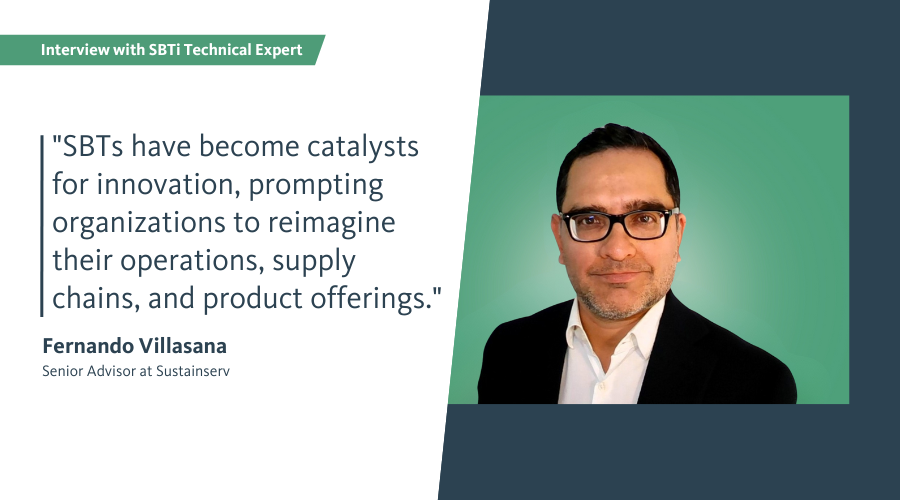The Science Based Targets initiative (SBTi) plans to launch its Corporate Net-Zero Standard (CNZS) Version 2.0 in 2027. Companies worldwide are grappling with how to transform climate ambitions into measurable action. In this interview, we speak with Fernando Villasana, former Head of Sector Development at SBTi and now Senior Advisor at Sustainserv, about the most significant changes in the updated framework – particularly the shift from simply setting targets to demonstrating real progress through periodic performance assessments.

What motivates your continued work in sustainability?
Fernando Villasana: My passion for sustainability started early in my career while doing environmental impact assessments and air quality compliance, and later over numerous site visits to GHG abatement projects where I witnessed firsthand the potential impact of well-implemented sustainability solutions. Observing the scale of benefits – both environmental and social – reinforced my belief in the positive role that corporations can play in addressing complex global challenges. Since becoming a parent in 2013, this commitment has deepened, as I feel a profound responsibility to contribute to a sustainable future for the next generations.
Was there a moment when you realized how urgent climate action is?
FV: When I started working on climate topics in 2007, my concerns centered on distant risks like rising sea levels, severe weather events, and ecosystem degradation. But it wasn’t until the release of the IPCC Fifth Assessment Report (AR5) that I began to understand more clearly the interaction between climate change and other planetary boundaries, which – through various feedback loops – unequivocally accelerate these problems and lead to cascading effects with abrupt and irreversible impacts.
My personal “tipping point” was realizing that unless we take immediate responsibility for addressing the climate crisis, our legacy will be a planet that no longer offers safe operating conditions for humanity and nature.
What’s something that surprised you while working with science-based targets?
FV: One of the most enlightening aspects has been observing ESG practitioners recognize and embrace the value of science-based targets to strengthen sustainability efforts within their own organizations. While, in the past, many companies approached climate targets as just another item on a long list of ‘nice-to-have’ public commitments, SBTs have become catalysts for innovation, prompting organizations to reimagine their operations, supply chains, and product offerings. It’s been truly inspiring to see how the SBT concept and framework have helped sustainability managers unlock creativity and commitment across their organizations, allowing them to extend those efforts deep into their value chains.
From your perspective, what is the most significant change in the SBTi’s Corporate Net-Zero Standard (CNZS) Version 2.0, and how might it impact companies’ decarbonization strategies?
FV: The most pivotal shift in the draft CNZS v2.0 is that the SBTi will transition from solely assessing ambition to a stronger emphasis on measuring and demonstrating progress. The new draft introduces, for the first time since the initiative was launched, mechanisms for periodic performance assessments, ensuring that companies not only set science-based targets but also actively track and adjust their strategies to meet them. This change can both enhance the credibility of targets and provide stakeholders with clearer insights into a company’s net-zero journey – so long as companies translate their decarbonization strategies into actionable and transparent transition plans.
How does the SBTi’s Net-Zero Standard Version 2.0 address the challenges companies face in reducing their Scope 3 emissions, and what practical steps can organizations take to meet these updated requirements?
FV: The new draft of the CNZS acknowledges long-standing challenges in managing Scope 3 emissions, such as their indirect nature and the complexities of value chain dynamics. To address this, the draft standard offers more nuanced guidance and introduces a more flexible approach, allowing companies to set alignment targets alongside – or in lieu of – emissions reduction targets. Setting alignment targets may involve strategies like prioritizing procurement from net-zero-aligned suppliers or increasing revenue from low-carbon products and services.
In practice, this means that companies should begin by mapping their value chain to identify emission hotspots and areas where they have significant influence. Engaging with suppliers to encourage or mandate science-based targets, integrating sustainability criteria into procurement processes, and investing in collaborative initiatives can drive meaningful reductions. Furthermore, transparent reporting and continuous monitoring are essential to track progress and make necessary adjustments.
How should companies prepare now, even though the new SBTi 2.0 standard won’t apply until 2027?
FV: While the CNZS v2.0 will officially come into effect in 2027, proactive preparation is crucial. Companies should begin by familiarizing themselves with the draft guidelines, participating in the public consultation by providing feedback, and assessing how their current strategies align with the forthcoming requirements. This will likely require reevaluating Scope 3 inventories, enhancing data collection processes, and engaging stakeholders across the value chain.
For companies embarking on net-zero journeys, my advice is to approach the process with both ambition and pragmatism.
Setting science-based targets remains a critical first step while the new framework enters into force, but it’s equally important to embed sustainability into the core business strategy, ensure cross-functional collaboration, and maintain transparency in reporting. Recognizing that the path to net-zero is iterative, companies need to be prepared to learn, adapt, and innovate along the way.
If you would like to dive deeper into SBTi 2.0, please have a look at our article ‘SBTi 2.0: A New Paradigm for Corporate Climate Strategies‘.
Get in touch. We are happy to tell you more about it.





